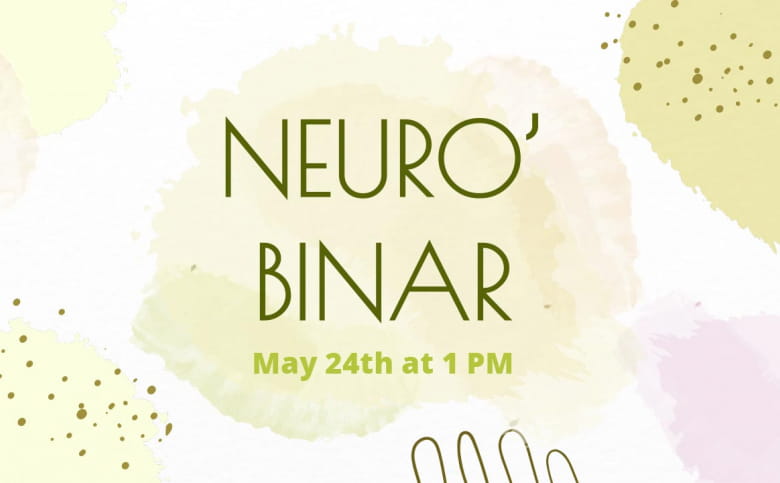
Neurobinar #14 : May 24th at 1pm on Zoom
For this fourteenth neurobinar, join us online and learn about the work of Julie Koenig Gambini (INMED), Florence RICCARDI (MMG), and Manon Chateaux (ISM). Register on this page to receive the link to the webinar.
Take a break to get to know your colleagues!
On May 24 at 1pm, join us online and learn about the work of Julie Koenig Gambini (INMED), Florence Riccardi (MMG), and Manon Chateaux (ISM). Florence and Manon will each present the other’s doctoral project in a cross-presentation. After a Q&A session for the PhD students, Julie will share with us her progress in her research work.
Format
The conference takes place online for one hour. It is composed of two parts: first, two PhD students give a 5-10-minute cross-presentation, each on the other’s thesis topic. After 5-10 min of questions, they pass the floor to a researcher, postdoc or engineer from the neuroscience community who presents an accessible version of his or her research in 20 min. Again, a question and answer session follows the presentation, and this is an opportunity to question the researcher, debate on the topic of the day and get to know your colleagues better
Register to receive the Zoom link
The speakers on May 24
Log in and discover the PhD project of Florence Riccardi (MMG) presented by Manon Chateaux (ISM) and vice versa. The presentation of the two PhD students will be followed by the presentation of the work of Julie Koenig Gambini (INMED). You will also have the opportunity to ask your questions and to review the Neurobinar on our YouTube channel.
Learn more about our guests with a summary of their background, bibliography and contact information.
Julie Koenig Gambini is a maître de conférences in the team of Jérôme Espztein at INMED in Marseille. She is studying the neurophysiological correlates of space and memory in the brain, with the aim of understanding the biological mechanisms of navigation. Julie Koenig Gambini studied psychology at Louis Pasteur university (Strasbourg) and did her PhD in the field of spatial cognition. During her thesis, she studied the involvement of the medial septum, a tiny brain nucleus, in the encoding, consolidation and recall of spatial information in rats. She then turned to in vivo electrophysiology to record place and grid cells that are spatially modulated neurons located in the hippocampus and medial entorhinal cortex, respectively. Her post-doctoral work in the team of Stefan leutgeb at UCSD, proved, for the first time in adult rats, that grid cells are not a prerequisite for the spatial modulation of place cells. She then moved to Seoul, in the lab of Sebastien Royer, where she studied how reward information are encoded in hippocampal networks. In 2014, she moved back to Europe, in Marseille, in the team of Jérôme Epsztein and is now studying how place cells integrate two streams of information (external and internal cues). In 2019, they published the first French paper using virtual reality in rodents showing that the hippocampal spatial map is not homogeneous, but that its resolution could be increased locally in areas rich in proximal visual cues.
Florence holds a doctorate in medicine and a specialization in medical genetics at Aix-Marseille University. After her residency, she did a fellowship in the Medical Genetics department of the children's hospital La Timone in Marseille. Currently, she is a part-time consultant in clinical genetics at the medical genetics department of the Sainte Musse Hospital in Toulon. Regarding scientific background, Florence obtained a Master’s degree in Genetics at the University Paris-Diderot in 2017. She has chosen to start a PhD in human neurogenetics in parallel with her clinical activities in 2020. Her PhD focuses on the development of RNA interference therapy in KCNQ2-related developmental and epileptic encephalopathies under the supervision of Laurent Villard (MMG, U1251 Inserm). She is also particularly interested in identifying the causes of autism and intellectual disability.
Manon is a 2019 graduate of ENS Paris-Saclay. She obtained her master's degrees in cellular neuroscience and biomedical engineering in collaboration with Sorbonne University and ESPCI Paris Tech respectively. Currently, she is a PhD student at ISM (Institut des Sciences du Mouvement) under the supervision of Jozina De Graaf. She is studying phantom hand movement in transhumeral amputees using MEG and fMRI to better understand the underlying sensorimotor loop and why phantom movements are reported to be particularly slow and to require demanding effort.











